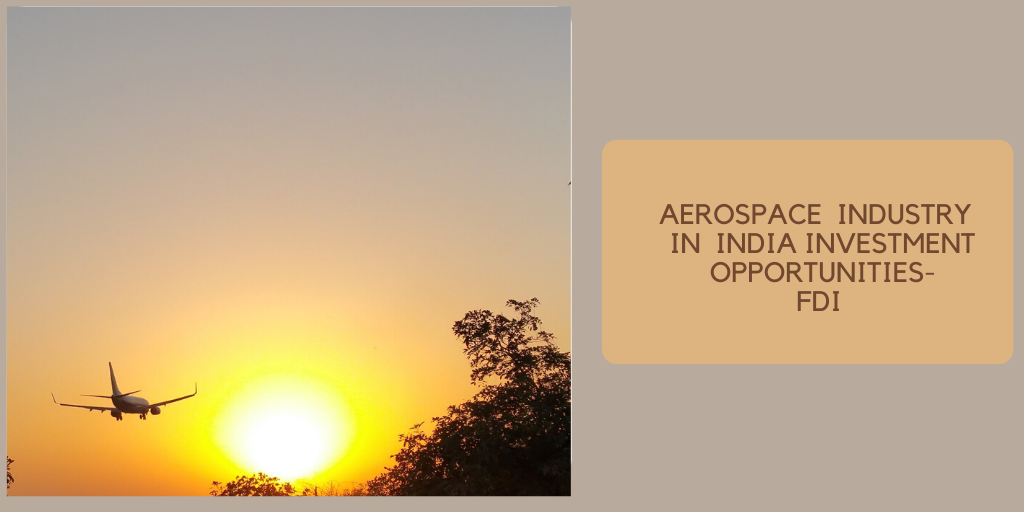The Indian aerospace industry is one of the fastest growing aerospace markets in the world. the country has an excellent pool of resources matching global standards. India’s liberalized economy offers sound opportunities for international companies that look to outsource Manufacturing and Maintenance, Repair and Overhaul (MRO) activities. India’s aerospace sector is at an inflection point. Various estimates put Aerospace & defence expenditure on acquisitions at around Rs. 5 lakh Crore (US$ 100 Billion) over the next 10 years. Robust growth potential of the industry is attracting original equipment manufacturers (OEMs) in this sector to setup facilities in India thereby providing tremendous opportunity for all stakeholders. With a size of US$ 16 Billion, – investment opportunity in india
The Indian civil aviation industry is ranked amongst the top 10 globally. It is in the space industry that India has made even more significant strides – it is one of the six countries in the world that undertakes space launches with commendable work put in by Indian Space Research Organisation (ISRO). ISRO has successfully ope rationalized two major satellite systems mainly Indian National Satellite for communication services and Indian Remote Sensing (IRS) Satellite for management of natural resource –
GROWTH PROSPECTS
The Defence Procurement Policy (DPP-2011) has included civil aviation equipment in the list of direct offsets. This has boosted the Indian aviation market and by 2017 the same is projected to be among the three largest markets globally.
i) The MRO segment in India is envisioned to attain Rs. 1300 Crore by way of 2020. Given the labour extensive nature of MRO, severalmain MRO companies, OEMs and worldwideairlines have outsourced heavy preservation work to India
ii) The u . S . A . has been upgrading its airports to international standards, catering to heavier cargo and passenger visitors. Private airways now account for 75% of domestic aerospace market
iii) Growth in air visitors is predicted to outperform the worldwide average till 2025. In navy aviation, India is predicted to spend about $35 billion over the next 20 years because it replaces its present fleet. Indian MRO section has been growing at 11 percent and has not been affected substantiallyby means of the slowdown. This market is expected to grow at a mean of 10% and reach $ 2.6 billion by way of 2020.
iv) The Indian Government has recognized the want for massive investment to meet these developing wishes:
The Ministry of Civil Aviation estimates funding of $ 200-three hundred billion over the subsequent 25 years, until 2034. The Airports Authority of India has planned funding of $ 3.04 billion to upgrade airports throughout the united states, at the same time asthe arena is open for public personal partnerships (PPPs). According to Boeing, India desires 856 airplanes worth $ 72.6 billion over the subsequent 20 years to fulfill the surging demand.
v) The Defense Procurement Policy (DPP-2011) has included civil aviation equipment in the list of direct offsets. This has boosted the Indian aviation marketplace and with the aid of 2017 the same is projected to be many of the three biggest markets globally – investment opportunity in India
POLICY INITIATIVES
The Indian Government has liberalized the framework for operating in the aerospace industry considerably:
• Manufacturing and R&D activity is allowed 100% Foreign Direct Investment on automatic route in all areas, except air traffic services.
• 100% FDI permitted under automatic route for MRO, flying training institutes and technical training institutes.
• 100% tax exemption for airport projects for a period of 10 years.
• Tax incentives are given for investing in Special Economic Zones.
GROWTH FACTORS
the aerospace industry include both macro and micro factors that provide attractive fiscal benefits for developers and manufacturers:
a. growing domestic aircraft demand,
b. liberalization of civil aviation policies, offset requirements,
d. a strong domestic manufacturing base,
e. cost advantages, talent pool, and a liberal Special Economic Zones law,
g. globalization of Maintenance, Repair and Overhaul (MRO) services,
h. manpower cost competitiveness,
i. availability of talent, & locational advantages,
k. use of technologies such as increased use of composites, modern engine technology, all weather capabilities, etc – investment opportunity in India
FDI POLICY IN AEROSPACE
The defence sector was opened up to 100% for Indian private sector participation, with FDI permissible up to 26%, both subject to licensing and Government approval. However, this cap and the accompanying conditions failed to attract FDI with a mere 5 million USD having come in since 2001. Recognising this, the new Government decided to raise the cap to 49% through the FIPB approval route and has further decided that FDI beyond this will be allowed by the Cabinet Committee on Security only where cutting-edge technology is being transferred.
The Indian aerospace industry is moving into an era of multinational cooperation, or ‘horizontal specialisation’, where original equipment manufacturers as well as 6 service suppliers seamlessly integrate functions such as engineering, manufacturing, and customer support across multiple global locations.


Add a Comment